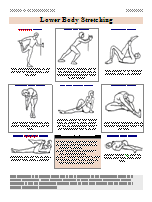Introduction
 Dr. Sanders | Who says Information Technology is not hazardous to your health? The U.S. Department of Labor reported 20,690 work-related "non-fatal injuries involving days away from work" for I.T. workers in 2005. Dr. Jerry Sanders, D.C., was kind enough to spend an hour with me discussing some of the common injuries that afflict I.T. professionals and how to avoid them. Dr. Sanders has been in practice in New Jersey for 32 years. He can be reached via his website at |
Interview
Q: I.T. jobs are often seen as a "safe", since you work indoors and the
physical demands usually aren't that great. What are some of the most common injuries that
afflict I.T. professionals?
It depends on what your job function is, really. For people who set up servers and
workstations, move heavy computer equipment around, or pull cables through the walls and
ceiling, pulled and strained muscles are common.
For a programmer, which tends to be a more sedentary job, backaches, neckaches, and pinched
nerves tend to occur more frequently. Some problems are common for everyone in the field,
however. Headaches and repetitive stress injuries, particularly in the hands, are
very common. Prevention is extremely important.
Q: You say prevention is important. Do you have any specific recommendations?
First off your body should be comfortable on the job. If you are constantly adjusting your
body to find that comfortable position, your body is trying to tell you something. A lot of
people sit in uncomfortable positions and don't even realize it because their bodies are
constantly compensating subconsciously. For many, it's important to pay conscious attention
to your sitting or standing position, to how your body is adjusted — to where your feet,
hands, and legs are situated — to determine how comfortable your body is.
There are several things you can do to avoid permanent injuries, or to keep injuries from
getting worse. Some of the more common problems include:
- Pain in your hands and wrists could be a sign of the beginnings of a serious repetitive
stress injury. If you start experiencing persistent pain in your hands, try giving them
a rest at regular intervals throughout the day. Also you might try a new keyboard, a more
ergonomic mouse, wrist rests, and maybe even a wrist brace.
- Persistent pain in the back and neck can be caused by a lot of different things. Poor
posture while you sit is a major cause. Broken or wobbly chairs, which force your body to
constantly correct its balance, are another. And a big problem in office settings is a
computer monitor turned at an angle to your body, or at the wrong height. When you are looking
at a computer monitor, it should be directly in front of you with the top of the screen
positioned at eye level. Monitors that are placed too high or too low will cause you
to strain your neck, or assume poor body posture to compensate.
- If you spend a good deal of time on the telephone, it's a good idea to use headphones or a
speakerphone instead of holding the telephone receiver with your neck and shoulder. Trying to
hold the receiver with your neck can lead to stiff neck, headaches, and spinal problems.
- Another problem is lifting and moving large objects (like servers) unsafely. If your job
includes heavy lifting, you should take special care to avoid injury. Always bend with your
knees and not your back.
A very common issue with some of my patients results from carrying lap-top computers with
shoulder-strap bags. Carrying the computer on one shoulder all the time can strain the
shoulder. I always recommend to my patients, at the very least, that they switch shoulders
regularly. This might be a little uncomfortable at first, especially if you're used to
carrying it on one shoulder, but most of my patients get used to it quickly and it helps
considerably — especially with maintaining good posture while walking.
Q: I'd like to talk about a few of the specifics you covered. You mentioned the
computer monitor on a desk should be positioned directly in front of you to prevent neck
strain. What about people with two monitors?
Well, for two monitors the same thing applies. If you work with two monitors, turn your
body (not just your head and neck) to face the monitor you are working with. This will help
prevent neck strain, and it also helps the back since you're not twisting your body to one side
to see the second monitor.
Q: You also mentioned repetitive stress injury in the hand and wrists. What type of
keyboard and mouse do you recommend?
I don't have a particular brand name to recommend. There are so many options available
these days. Some people prefer an ergonomic keyboard with an angled shape, while others prefer
a regular keyboard with a height adjustment. As for the mouse, some people prefer a trackball
over a regular mouse because they don't have to move their wrists as much, but the important
thing is to find peripherals that are comfortable for you. And don't be afraid to try a new
style of keyboard or mouse. It's a small investment for something simple that can help prevent
major problems down the road.
Q: What do you mean by "major problems down the road"?
Well, repetitive stress injuries are often a precursor to carpal tunnel syndrome. These are
very serious injuries that are extremely painful and can literally prevent you from getting any
work done for days, or even weeks, at a time. In the most serious cases it can require
surgeries and prescription medication just to help manage the pain. The search for a
comfortable mouse and keyboard is a very small price to pay to help avoid these types of
injuries.
Q: And what's the best way to avoid injuries if you have to do heavy lifting on the
job?
You should always stretch before you move large objects. At the least, you should give your
arms, legs, and back a good warm-up. Of course you should always lift by bending your knees,
and your back. Just as importantly, use tools (like dollies or carts) to move large objects
whenever possible. For people who do a lot of heavy lifting regularly I might even recommend
getting a Trochanteric support belt.
Q: Whats a Trochanteric support belt? Is that a back brace?
It's a support belt designed to go around the hips, not the waist. The design keeps the
ligaments tight to give extra support. A regular "back-brace" belt that goes
around the waist waist provides support, but if worn for a long period these waist belts
can cause the muscles in the lower back to weaken.
Q: You keep mentioning good posture. What are some of the things we can do to maintain
good posture?
Yes, good posture is key, and will prevent a lot of problems. Basically good posture
consists of keeping the back straight, and the spine and head upright. When sitting, you
should be seated well back into the chair. A small cushion can be placed in the back of the
chair, or a chair with built-in lumbar support, will help offer some support as well. To
reduce stress on the legs and back, sit with your knees at the same height as your hips; some
people use an adjustable footrest for this, and most office chairs these days are adjustable.
Q: OK, I have to ask this. There was a popular sitcom on TV, and in one episode one of
the characters says his doctor told him not to carry a wallet — because it was bad for
his health. Is there any truth to this?
As a matter of fact, yes. Sitting on a bulky wallet raises one hip higher than the other,
and tilts the foundation of the spine to one side. That wallet in your back pocket can cause,
or worsen, a sciatica or lower back problem. If you have a bulky wallet, I recommend keeping
it in a side pocket when sitting. On a practical note, keeping your wallet in your front or
side pocket also makes it harder for a pick-pocket to steal it.
[Editor's Note: Sciatica is an inflamed nerve resulting from a pinched nerve in the
lower back area.]
Q: What about the eyes?
Protecting your eyes is very important. Obviously your monitor should have a bright, crisp,
high contrast, clear image. Nothing strains the eyes so much as a monitor with a low contrast
or fuzzy image. Staring at a fuzzy monitor 8 hours per day can cause eye strain, headaches,
and even eventually degrade your vision.
Another thing that people don't realize is that they normally blink once every 5 seconds (on
average). When staring at a computer screen, however, you will blink about once every 15
seconds. People who wear contact lenses and work on computers might notice that their eyes
seem to get particularly dry, and their lenses bother them, because of this. This is an
important reason to give your eyes a rest every once in a while. Even if you just stare away
from the monitor for a minute or so every fifteen minutes, it will give your eyes a chance to
refresh themselves.
Newer (LCD) flat-panel monitors are easier on the eyes than older (CRT) monitors because
they don't have to refresh the entire screen 60 or 70 times per second. They also tend to
have better contrast which helps. Also they (LCD monitors) don't emit as much radiation, which
is better on the eyes and your body in general.
[Editor's Note: If you are concerned about monitor radiation, look for TCO'99 (or
newer) and/or MPR II certification. These are strict standards that cover radiation emissions
from monitors. More information on all aspects of monitors is available at
http://www.lcdtvbuyingguide.com/lcdtv-crt.shtml]
Q: At what point do you recommend seeing a chiropractic physician about your aches and
pains?
Whenever your pains don't go away with a good night's sleep, or if you notice your posture
is not good. Here's a little test you can do at home, with the help of another person:
- Lie down flat in a prone (face-down) or supine (face-up) position; your leg length
should be even.
- Turn your head to the left (just your head), and have the other person look at the length
of your legs.
- Turn your head to the right and have the person look at the length of your legs again.
- If you're lying face-down, bend your legs at the knees while lying down and have the other
person inspect their length again.
In all of these tests, the length of your legs should stay even. If not, it's a sign you
might benefit from a chiropractic adjustment.
Q: OK, one final question. Are there any vitamins or natural supplements people
can pick up locally that will help prevent problems?
Well, everybody's eating habits vary, but a good multivitamin and mineral supplement is
often helpful. I can't recommend specifics for non-patients, but you can consult a
nutritionist or physician to create a specific dietary plan just for you.
Download Dr. Sanders' Guide to Stretching Here


